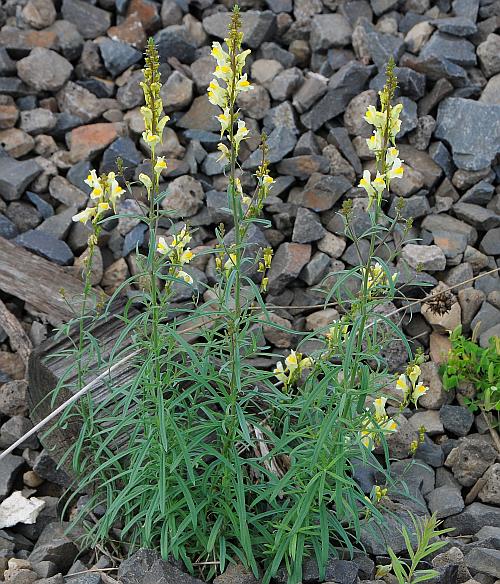Linaria vulgaris Mill.
Butter And Eggs

Introduced
CC = *
CW = 5
MOC = 40
© SRTurner
Linaria vulgaris Mill.Butter And Eggs | |
 |
Introduced CC = * CW = 5 MOC = 40 |
© SRTurner |
|
Family - Plantaginaceae Habit - Fibrous-rooted perennial forb. Stems - Ascending to erect, to 80 cm, glabrous.
Leaves - Alternate, the lowermost sometimes subopposite, simple, entire, sessile or nearly so. Blades 2-7 cm long, 1.5-6.0 mm wide, linear, angled or slightly tapered to a sharply pointed tip, tapered at the base, unlobed, usually only a midvein apparent, glabrous.
Inflorescences - Dense terminal spikelike racemes, the flower stalks 1-4 mm long at flowering, each subtended by a linear to lanceolate bract 3-25 mm long; bractlets absent.
Flowers - Perfect. Calyces 2.5-4.5 mm long, deeply 5-lobed nearly to the base, the lobes slightly unequal in length, lanceolate, sharply pointed at the tip, glabrous. Corollas 20-30 mm long (including the spur), bilabiate, 5-lobed, glabrous except for the bearded base of the lower lip, the tube shorter than to about as long as the lobes, light yellow with a darker yellow and orange throat, the tube with a straight or somewhat curved, slender spur 8-14 mm long at the base, the throat mostly closed by the strongly convex base of the lower lip, the upper lip more or less straight, strongly folded longitudinally between the 2 lobes, the lower lip with the lobes more or less recurved. Fertile stamens 4, the filaments of 2 lengths, not exserted, the anther sacs spreading; staminodes absent (but the lower lip bearded at the base). Style 1, not exserted, the stigma capitate, unlobed.
Fruits - Capsules 5-10 mm long, ovoid to more or less globose, glabrous, the 2 locules each dehiscent from the tip by 3-5 teeth. Seeds numerous, 1.5-2.5 mm long, circular to broadly oblong-elliptic in profile, flattened and with a broad marginal wing, the surface black, the main body with scattered small warts or tubercles. Flowering - May - November. Habitat - Fields, pastures, roadsides, railroads, cemeteries, old homesites, open disturbed areas. Origin - Native to Europe. Lookalikes - Potentially, L. dalmatica (which has not yet been documented in Missouri). Other info. - This visually attractive species occurs in scattered locations in Missouri. It is far more common in most of the northern half of the continental U.S., as well as most western states. In many of the latter it is considered a noxious weed and a significant invader of natural communities. Its behavior in Missouri thus far is more benign. The interesting flowers and inflorescences make this plant hard to mistake for anything else. Another member of the genus, L. dalmatica, is also very common to our west. It has been found in counties just across the Kansas border and it is reasonable to expect that it will eventually be found in Missouri. It is distinguished from L. vulgaris by having leaves which are much wider and clasp the stem. Both plants are very popular in cultivation and grow easily from seed. Photographs taken in Marquette, MI., 9-10-03 (DETenaglia); also along the Rock Island Trail, El Paso County, CO, 8-29-2013, along a railroad track in Kalamazoo, Kalamazoo County, MI, 9-16-2014, and in Larimer County, CO, 7-31-2017 (SRTurner). |